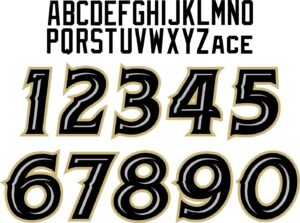Are you familiar with fancy number fonts? Although seemingly minor, small details can significantly affect any design project’s overall appearance and ambiance. This article provides an in-depth analysis of fonts, including their quantity, origin, various categories, and the process of selecting the appropriate one for your design project. We’ll also provide examples of different fancy number fonts and best practices for using them effectively. Upon concluding this article, you will better understand how fancy number fonts can augment your design work and how to exploit their potential fully.
Discovering the History of Fancy Number Fonts
The utilization of number fonts can be attributed to the nascent days of typography, in which numbers were painstakingly drawn by hand and incorporated into various printed media, including books, newspapers, and posters, making them distinctive and exclusive. The first number of fonts were simple and often mimicked the handwriting style of the time. As typography evolved, so did the complexity of number fonts, creating more elaborate styles. During the 19th century, the employment of fonts was standardized with the invention of the printing press, and the diversity of fancy number fonts was no exception.
Currently, designers can choose from a vast selection of number fonts, each possessing distinct characteristics that facilitate the discovery of the ideal font for any design project. This led to creating new styles, including serif and sans-serif number fonts. The 20th century saw the development of more experimental number fonts, including display fonts and script fonts, which added even more variety to the world of typography. Multiple types of number fonts copy paste exist, each possessing a unique style and purpose, ranging from bold and blocky to sophisticated and decorative. The selection of an appropriate number font for a design project is a crucial decision that can significantly impact the overall appearance and atmosphere of the project.
Types of Fancy Number Fonts
There are several types of number fonts to choose from, each with its unique style and purpose. Here are some of the most common types of number fonts:
- Serif: Serif number fonts are characterized by the small lines or flourishes that extend from the edges of the numbers. They are generally considered more traditional and formal, making them a good choice for projects that require a classic or sophisticated look.
- Sans-serif: Sans-serif number fonts do not have small lines or flourish at the edges, giving them a more modern and clean look. They are often used in digital or web-based designs, as they are easier to read at smaller sizes.
- Display: Display number fonts are often used for large headings or titles, as they are designed to be eye-catching and attention-grabbing. They come in many styles, from bold and blocky to elegant and decorative.
- Script: Script number fonts are designed to look like handwriting, with flowing lines and curves. They are often used in invitations, greeting cards, or other projects that require a personal or romantic touch.
By understanding the different types of fancy number fonts available, designers can choose the right font for their project and achieve the desired look and feel.

How to Choose the Right Fancy Number Fonts
Selecting the appropriate number font for a design project is a significant decision that can profoundly influence the project’s overall appearance and ambiance.
Here are some tips on how to choose the right number font:
- Understand the purpose of the font: Before choosing a number font, it’s important to consider the purpose of the design project. Is it for a formal event, like a wedding invitation, or a more casual project, like a social media post? This will help determine the appropriate style of font to use.
- It is crucial to consider readability when selecting a number font, particularly if the numbers are the central focus of the design. Therefore, choosing a number font that is easily legible and readable is necessary. Avoid overly ornate or decorative fonts that make the numbers difficult to read.
- Match the font with the design style: The number font should complement the overall style of the design. To illustrate, a minimalist design may benefit from a modern sans-serif font, whereas a script font may better complement a romantic or whimsical design.
- Test the font: Before finalizing the choice of number font, it’s a good idea to test it in the actual design to see how it looks and feels. This will help ensure the font works well with the other design elements and achieves the desired effect.
By following these tips or using this number font generator, designers can choose the right love font style for their design project and create a cohesive and visually appealing final product.
Examples of Fancy Number Fonts
Countless fonts are available to designers, each with a unique style and personality. Here are some examples of different number fonts:
- Serif Font Examples: Times New Roman, Baskerville, Georgia
- Sans-serif Font Examples: Arial, Helvetica, Futura
- Display Font Examples: Impact, Bebas Neue, Lobster
- Script Font Examples: Brush Script, Edwardian Script, Lucida Calligraphy
These are just a few examples of the many number fonts copy paste available. It’s essential to choose a font that fits the overall style and purpose of the design project while also being legible and easy to read. By experimenting with a different number of fonts, designers can find the perfect font to achieve the desired effect in their design work.
Best Practices for Using Number Fonts
Here are some best practices for using fancy number fonts effectively in design projects:
- Using a limited number of fonts is preferable to avoid creating visual clutter and unprofessional-looking designs.
- Use appropriate font sizes: Ensure that the font size of the numbers is appropriate for the design project. For example, larger font sizes may be needed for a title or heading, while smaller font sizes may be appropriate for body text.
- Pay attention to spacing: Proper spacing between numbers is important for legibility and visual appeal. Ensure the spacing between numbers is consistent and not too tight or loose.
- Use contrast to make the numbers stand out and draw attention to them. Contrast can be achieved through the use of color, font size, and font style.
- Consider accessibility: Consider accessibility when choosing several fonts, particularly when designing for digital platforms. Choose a font that is easy to read and legible, especially for people with visual impairments.
By following these best practices, designers can effectively use many fonts to enhance their design projects’ visual appeal and readability.



![Async Await c# Error Handling [SOLVED!]](https://mycodebit.com/wp-content/uploads/2023/10/rich-tervet-q2GNdFmhxx4-unsplash-360x240.jpg)

![How to Handle Divide by Zero Error in c# [Complete Guide]](https://mycodebit.com/wp-content/uploads/2023/10/clement-helardot-95YRwf6CNw8-unsplash-360x240.jpg)
